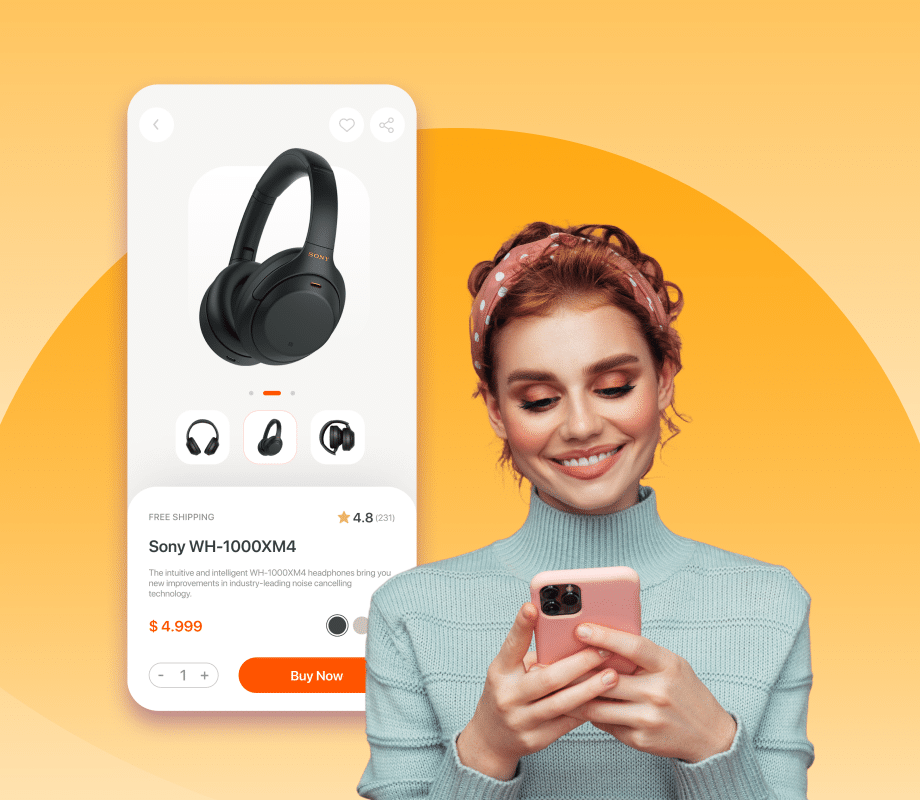From Segmentation to Individualization – Part 3
In the previous two articles of this series, we set the stage for you to understand why it’s important to move from rule-based segmentation to individualization.
Now, let’s dive right in and take a look at five proven strategies to deliver ML-powered 1:1 personalization to your customers.
-
Personalize for First-time Visitors Using Wisdom of Crowd
Wisdom of Crowd (WoC) is an ML-based personalization strategy that combines insights and trends from general visitor behaviors and draws correlations between products. Using these insights, the strategy can recommend products with similar styles, brands, models, or colors of the product a visitor views first.This strategy is quite useful for first-time visitors to your site—when you don’t have any historical or behavioral data about them.
Another place where WoC works well for new users is search personalization. Say Jack enters the search query “laptop” on an electronics store website. The average search results for this query will include an array of products labeled “laptop” on the site’s product metadata.
However, by employing Wisdom of Crowd, you can prioritize showing the most purchased and most viewed laptops in the search results. These results are likely to be more relevant because they would be trending and latest products.
-
New Products Getting Ignored by Product Recommendation Engines? Let NLP Help
When new products are added to your inventory, they usually don’t get picked by recommendation engines because of lack of data (pageviews, click-throughs, purchase, purchase co-occurrence). This is a lose-lose: your customers miss out on discovering these new products and you miss out on getting enough sales for the product.This is where Natural Language Processing (NLP) algorithms come in handy. Instead of relying on behavioral or transactional data related to the product, NLP “reads” the product descriptions and metadata, and extracts the key attributes.
It then forms associations among products based on feature compatibility, semantic similarity, and word vectors. Accordingly, it delivers product recommendations for alternative products, cross-sell, or upsell.
NLP is useful for new products, niche products such as special needs cosmetics, or long-tailed products such as rapidly sinking food for bottom-feeders in fish tanks. It uncovers buried treasures in your inventory and helps customers discover them easily.
Case Study
Learn how Neowing and CDJapan leveraged NLP to improve product discovery of new and long-tail products, which form over 96% of the catalog.

-
Cross-sell the Right and Most Relevant Products
When a user views a product or adds one to the basket, show them not just items based on visual or category similarity, but products complementary to the one being viewed. This is especially applicable to products such as printers, mobile phones, or laptops that need specific accessories.To hyper-personalize the right cross-sell products, ML-based personalization engines deep-dive into different kinds of data. These include purchase co-occurrence data, attributes extracted from product descriptions and metadata through NLP, and compatibility data extracted from advanced merchandising, among others.
This ensures that you are able to show to your users not only the right complementary products for the model or brand, but also a wider variety of them, increasing the chances of getting higher conversions and average order values.
-
Personalize Different Kinds of Email Campaigns
Email personalization is not uncommon, but have you considered the different ways emails can be individualized?Adding customer’s first names to the subject line and copy or sending emails on customers’ birthdays are just basic strategies. Go many steps ahead and add product recommendations to automated email campaigns to maximize their ROI.
Global conversion rates of cart abandonment emails stood at 34% in 2020. In addition, click rates of personalized promotional emails can be 41% higher than those for non-personalized emails. Do you need more convincing to add product recommendations to your emails?
Personalize product recommendations on email campaigns such as:
-
Browse abandonment (searches, viewed products, similar/alternative products)
-
Cart abandonment (searches, viewed products, similar/alternative products)
-
Out-of-stock alerts (similar/alternative products)
-
Back-in-stock alerts based on the customer’s geolocation
-
Post-purchase (cross-sell and upsell recommendations)
-
Replenishment mails for frequently purchased and repeated use products
-
New product releases in product categories the customer has purchased or viewed previously
-
Sale alerts with countdown timers for purchased or viewed product categories
-
Offers curated to the customer’s milestones (anniversaries, birthdays, and relationship with the brand), demographics, and purchase patterns
An important email personalization strategy that is not used well enough is open time personalization. This kind of email content personalization allows you to deliver contextually relevant and individualized engagement in real time. Read more about open-time personalization here.
-
-
Hyper-personalize Offers and Product Recommendations at Physical Stores
Make customer profiles available to physical stores so that sales executives can see the customer’s preferred brands or styles, recent and frequent purchases, and other affinities.This can help them individualize the in-store experience of customers even if the person is visiting the store for the first time. They can recommend products from the customers’ favorite brands, show them the latest arrivals of their favorite products, offer them discounts on higher-value purchases or higher basket sizes, and much more.
Be Where Your Customer Is: Implement Omnichannel Personalization
When you have a centralized repository for dynamic 360-degree customer profiles, you can extend hyper-personalization across various digital and offline channels.
Here’s a quick list of the channels you can deliver individually personalized experiences on:
-
Website
-
Mobile and web apps
-
SMS
-
Email
-
Social media
-
In-store
-
Customer support centers
Most users these days interact with a brand on different channels in a single buying journey. For example, you may search for products and add products to cart on the website via desktop, and then open the mobile app to complete the transaction because it’s more convenient.
Or you might look up products on the website or app, then visit the nearest physical store to try out the products, and then complete the purchase on the website or app because the discounts are better online.
So, omnichannel personalization is the way to go.
Use apps for personalized push notifications to alert customers about items in cart, offers on their favorite brands or product styles, or about new product releases.
Use personalized emails and targeted adverts on social media and third-party channels to re-engage with them and reduce churn.
Arm your sales and customer support executives with customer profiles to help them deliver individualized experiences in-store and on call/chat/email.
All this and more is possible with Algonomy’s Personalization Suite. Contact us to learn more and get a demo.
This is the third and last part of a three-part series on the importance of individualized customer experiences in eCommerce and how to deliver hyper-personalization.
 in Sweden from 7 - 8 October 2025. Pre-book a meeting to connect with our
product experts.
in Sweden from 7 - 8 October 2025. Pre-book a meeting to connect with our
product experts.










